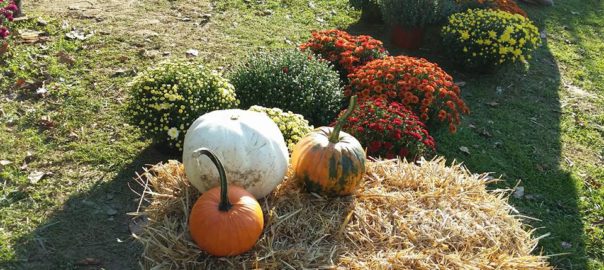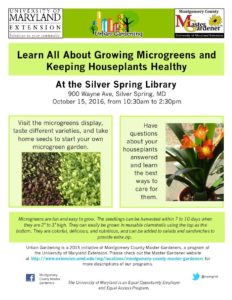Hello Friends, Neighbors, Fellow Gardeners,
It’s October, time to enjoy the crisp fall weather and the fall harvest of apples, pumpkins, and more! Here are some garden tips, educational opportunities, and events for October. Events include the Harvest Festival at the Agricultural Historic Farm Park, A Forest Journey, Hispanic Heritage Month, Nature Matters Lecture Series, Cider Days, Pumpkin Panache Family Festival, and more!
Planning:
- Keep an eye out for the first frost date. In Zone 6, it is predicted to be between September 30 and October 30.
- When planning your wildlife-friendly backyard don’t forget to include native trees and shrubs that produce fall and winter persistent fruits.
- As beds empty, make changes to shape and size of beds.
- Clean, sharpen, and store your garden tools
- Take garden photos and make notes in your garden journal.
- Begin planning for fall plantings.
- Start collecting plant seeds for next year and for trading.
- Order spring-flowering bulbs to arrive for planting this fall.
-
Support our local farmers! Visit a local farmers’ market near you. Download Montgomery County’s Office of Agriculture Farmer’s Market Flyer to find a farmer’s market near you.
Flowers and Groundcovers:
- Divide and move many perennials.
- From mid-October through November, plant hardy bulbs for spring flowering.
- Cut foliage of irises to 2″.
- After hard frost, sow seeds of spring-blooming hardy annuals and perennials, then mark beds.
- Continue to deadhead spent flowers.
- Pull out spent summer annuals.
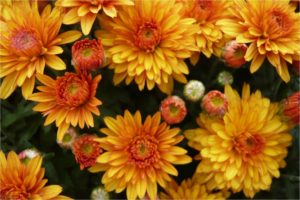
- Plant hardy mums and fall season annuals.
- Divide and transplant peony and iris perennials.
- Divide ornamental grasses.
- Take cuttings from coleus and begonias to propagate and over-winter indoors.
- Start seeds of pansies, calendula, flowering cabbage, kale, and other fall annuals.
- Pests to watch for: aphids, spidermites, whiteflies
- Diseases to watch for: Blackspot on roses; powdery mildew, rust, bacterial diseases, fungal leaf spot.
- See UMD’s HGIC’s October Flower tips for more details.
Trees and Shrubs:
- Transplant trees when leaves begin to change color.
- Plant evergreens for winter interest.
- Look out for any Poison Ivy vines, which will turn crimson in the fall and be easy to distinguish from other vines.
- Remove fallen, diseased leaves.
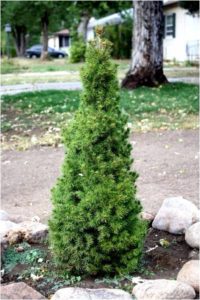
- Check for bagworms: pick off, bag, and dispose of them.
- Prune foundation shrubs and trees to be no closer than 1 foot from the house.
- If your conifers start shedding their needles or your spring bulb foliage starts peeking out of the ground, don’t worry. This is normal for our autumn cycle.
- Prune evergreens to get in shape for fall/winter.
- Prune and thin shrubs that have already flowered.
- Water newly planted trees and shrubs weekly or as needed.
- Pests to watch for: adelgids, aphids, bagworms, borers, caterpillars, leafminers, scale, sawfly, spidermites, voles, and webworms.
- Diseases to watch for: powdery mildew
- See HGIC’s October Trees and Shrubs Tips for more details.
Herbs, Veggies, and Fruit:
- Plant cover crops where nothing is growing in vegetable gardens and annual beds (e.g., rye, clover, hairy vetch, and winter peas)
- Set u a cold frame, then plant lettuces, radishes, and carrots from seed.
- Plant garlic for spring.
- Pick pumpkins at a local pick-your-own farm or visit a farmer’s market.
- Continue planting cool-season vegetables; plant garlic now through the end of October.
- Mulch strawberry beds for winter.
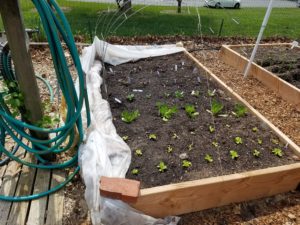
- This is a good time to have your vegetable garden and landscape soils tested.
- Harvest leaves of herbs used in cooking (rosemary, basil, sage) in the early morning for best flavor.
- Harvest most fruit before frost.
- At the end of the month, begin planting cool-season vegetables (turnips, carrots, beets, spinach, Chinese cabbage, cauliflower, kale, Brussel sprouts).
- Harvest sweet potatoes.
- Watch your pumpkins and squash. Harvest them when their rinds are dull and hard.
- Preserve gourds and dry flowers for display in the fall.
- Watch for insect and disease problems throughout your garden.
- Look out for slug eggs grouped under sticks and stones. They are the size of BBs and pale in color.
- Pests to watch for: asparagus beetle, aphids, cabbage worms, corn earworm, cutworms, and tomato hornworm
- Diseases to watch for: Fungal, bacterial, viral diseases
- Here are some more fruit and vegetable gardening tips for October from UMD’s HGIC.
Lawns:
- Have soil tested (every 3 years minimum).
- Apply lime as needed to adjust pH.
- This is the perfect time for seeding the lawn.
- Apply fertilizer and lime to turfgrass based on soil tests and UME recommendations.
- Plug aerate when soil is moist.
- Begin mowing leaves into turf to add organic matter and nutrients.

- Fertilize tall fescue and bluegrass with 1 lb. Nitrogen per 1000 square feet.
- Cool season lawns go dormant in hot, dry weather. Do Not Water.
- Some grasses can still be planted. Over seeding may be done now through October.
- Keep newly seeded lawns well watered!
- Water established lawns deeply but infrequently.
- Apply pre-emergent weed control such as corn gluten.
- Apply grub control to your lawn.
- Turn your compost pile weekly and don’t let it dry out. Work compost into your planting beds.
- Diseases to watch for: brown patch, and red thread
- Pests to watch for: Grubs
- See HGIC’s October Lawn Tips for more details.
Indoors/Houseplants:
- All plants should be inside now!
- Bring in tender plants before night temperatures dip to 60 degrees.
- Bring in house plants if you took them out for the summer.
- Take cuttings of plants you want to overwinter inside and place in water.
- Prune potted bougainvillea or hanging baskets that will overwinter inside.
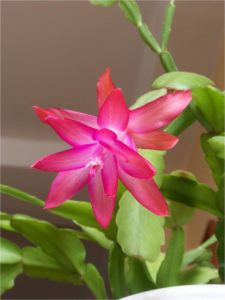
- Bring Amaryllis indoors before a hard freeze. Repot every other year at this time.
- For readying Christmas cactus and poinsettias for holiday blooming, see holiday blooming tips: Poinsettia Plant Care, Holiday Plant Care
- Remove old leaves, damaged stems.
- Monitor houseplants that are outside for insect problems.
- Fertilize houseplants now that they are actively growing again.
- Repot root-bound houseplants and start fertilizing them.
- Pests to watch for: aphids, mealybug, spider mites, whitefly and scale.
- See HGIC’s September Houseplants Tips for more tips.
Indoor/Outdoor Insect and Wildlife Tips:
- Start feeding birds to get them in the habit for the winter.
- Don’t put your birdbath away. Birds need fresh water for drinking and bathing throughout the fall season. Clean frequently and keep filled with fresh water.
- Clean your hummingbird feeders and add new sugar-water every three days.
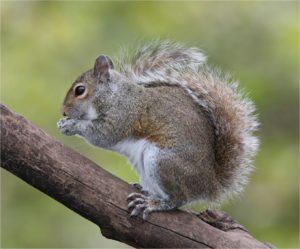
- Check for mosquito breeding grounds. Dump out any water that sits stagnant for more than three days.
- Switch your deer deterrent spray.
- See HGIC’s October Insect Tips for more details.
- Watch for: carpenter ants, flies, stink bugs, termites, rabbits, raccoons, groundhogs, deer, moles, snakes, squirrels, and voles.
- For more information on wildlife management and attracting wildlife see HGIC’s October Wildlife tips.
Source: University of Maryland’s Home and Garden Information Center (HGIC) and the Washington Gardener.
Please Support the Mill Creek Towne Garden Club
Hello Friends, Neighbors,
Please support the Mill Creek Towne Garden Club! Your donations will help us continue to provide garden-related programs to the community and pay for maintaining and landscaping the Mill Creek Towne main entrances. 
https://www.mctgardenclub.org/donations/
We accept donations throughout the year. Thanks to all of you that have recently donated as well as those of you who have supported us in the past years! Thanks for your continued support of the Mill Creek Towne Garden Club and our community programs!
Mill Creek Towne Garden Club – Derwood, Maryland
https://www.mctgardenclub.org | info@mctgardenclub.org | Like us on Facebook
October
See below for upcoming local events in October.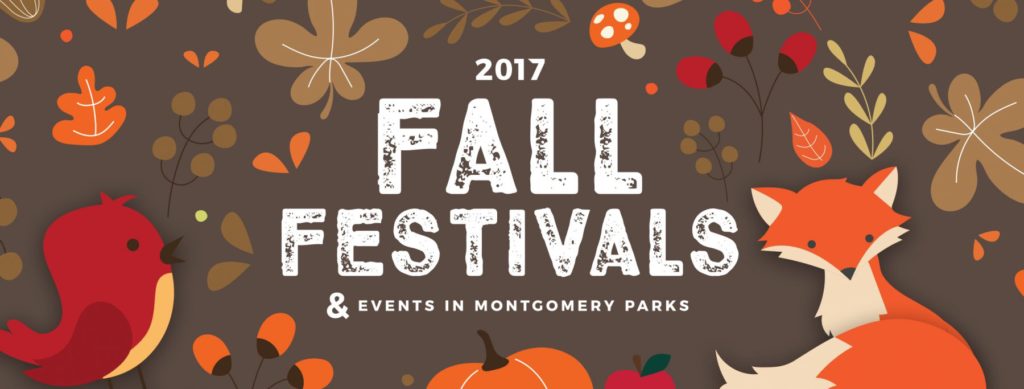
Montgomery Parks Special Events & Festivals
More events are being added regularly. Please check back often!
Save the dates for these upcoming events! Events include the Harvest Festival at the Agricultural Historic Farm Park, A Forest Journey, Hispanic Heritage Month, Nature Matters Lecture Series, Cider Days, Pumpkin Panache Family Festival, and more!
Master Gardener Plant Clinics
Varied Locations, dates, and times
What can Master Gardeners do for you?
- Help you select and care for annual and perennial plants, shrubs and trees.
- Determine if you need to test your soil.
- Provide you with information on lawn care.
- Identify weeds, beneficial and noxious insects, and plant diseases and remedies.
- Teach you how to use pesticides, mulch and compost.
- Guide you in pruning trees and shrubs.
- Provide you with options for managing wildlife.
- Provide you with gardening resources.
- Help you submit a plant sample for diagnosis
Plant Clinics are held at several sites in the county on a weekly basis and at special events such as garden festivals and the county fair. Regularly scheduled Plant Clinics are located at public libraries and farmers’ markets throughout the county as well as at the Audubon Naturalist Society in Chevy Chase. There are also clinics three days per week at Brookside Gardens. The busiest season is April through September, but some clinics are open year-round. Bring your plant samples and questions to one of these locations in Montgomery County, MD (see link below to find a location near you):
September 8 – January 2018 | 9 a.m. – 5 p.m. Tues. through Saturday | 1-5 p.m. Sundays
Brookside Nature Center, Wheaton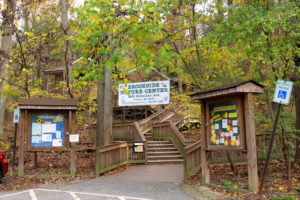
FREE
This rich and inviting interactive exhibit, created by the Franklin Institute, is inspired by the Harvard classic A Forest Journey: The Role of Wood in the Development of Civilization by science writer John Perlin. It sheds new light on the history of the use of wood throughout the world, on forest products (from paper to lifesaving pharmaceuticals) and on the relationship between forests and the benefits of trees.
Harvest Festival
Annual Ride for the Reserve -Fall Farm Bike Tour
Sunday, October 8, 2017
8:00am
Poolesville Golf Course
16601 W. Willard Road
Poolesville, Maryland 20837
Join us October 8, 2017 for this 10th annual fall tradition. Gorgeous Ag Reserve views on routes from 10-75 miles, farm stops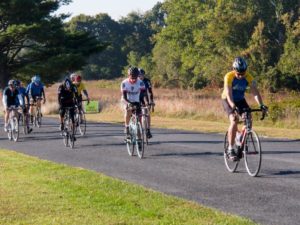 and a gourmet picnic with live music and cider tasting at Kingsbury’s Orchard. New this year is a 10 mile loop suitable for families and novice riders – along with discounts for younger riders.
and a gourmet picnic with live music and cider tasting at Kingsbury’s Orchard. New this year is a 10 mile loop suitable for families and novice riders – along with discounts for younger riders.
| Contact Name | Ellen Letourneau |
|---|---|
| Contact Phone | 248-683-9678 |
| Contact Email | ellen@mocoalliance.org |
| Cost | $80 adult – $10 (ages 12-16) |
| Link | http://www.mocoalliance.org/ridereserve2017.html |
Brookside Nature Center
Countryside Artisans of MD Fall Tour
Our Fall 2017 Tour will be on October 13, 14, 15, 2017.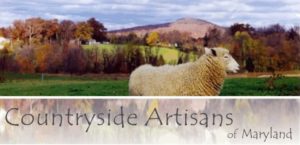
We hope you will enjoy this opportunity to meet the artists and craftsmen and see their workplaces.
The studios will be open from 10am-5pm on Fridays, Saturdays, and Sundays.
See link below for locations and contact information for each artisan.
| Location | Various gallery and studio locations listed on Brochure/Map. See link below for details |
|---|---|
| Age | Family |
| Area | Upcounty |
| Cost | Free |
| Link | www.countrysideartisans.com |
Urban Gardening Fall Event
Saturday, October 14
Silver Spring Library, 3rd Floor
900 Wayne Avenue,
Silver Spring, Maryland
Visit the Silver Spring Library, where Montgomery County Master Gardener volunteers will answer questions, offer information, give demonstrations (some with giveaways) on THREE hot urban gardening topics: Fall Cleanup and Composting, Planting for Spring Bulbs and Houseplants: Winter Care.
Free
